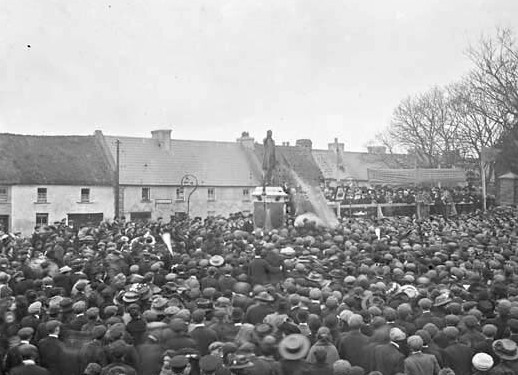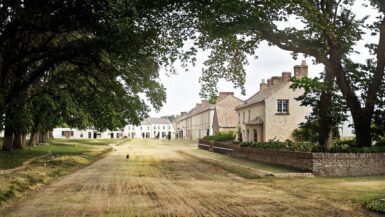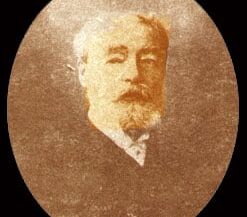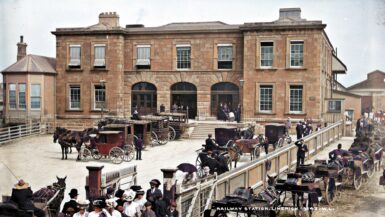Abbeyfeale, a historic market town situated in County Limerick, Ireland, near the border with County Kerry, boasts a rich history spanning over 900 years. The town’s Irish name, Mainistir na Féile, translates to “Abbey of the Feale,” referencing the Cistercian abbey that once stood adjacent to the current town square. Abbeyfeale’s strategic location in the foothills of the Mullaghareirk Mountains, along the banks of the River Feale, has played a significant role in shaping its history. The town’s development has been influenced by various factors, including religious establishments, notable figures, and key events throughout the centuries.
Contents
Early History
Founding of Cistercian Abbey (1188)
The history of Abbeyfeale is inextricably linked to the establishment of a Cistercian abbey in 1188. Founded by Brien O’Brien, the abbey was built near the River Feale, giving the town its name. The abbey’s presence attracted settlers and contributed to the growth of the surrounding area.
Abbey becomes cell of Monasteranenagh Abbey (1209)
In 1209, just two decades after its founding, the Abbeyfeale abbey became a cell of the larger Monasteranenagh Abbey, located near Croom in County Limerick. This connection to the larger religious institution further solidified the importance of the abbey in the region.
Destruction of Abbey by war (1306)
The early history of Abbeyfeale was not without its challenges. In 1306, the Black Book of Limerick recorded that the town and its abbey were destroyed by war. This event likely had a significant impact on the community, requiring rebuilding and recovery efforts in the following years.
Despite the destruction, the abbey remained a central part of Abbeyfeale’s identity. Its influence continued to shape the town’s development in the centuries that followed, even as the physical structure of the abbey eventually disappeared, with only remnants used in the construction of the Roman Catholic Church in 1847.
The Earls of Desmond
Thomas FitzGerald’s marriage to Catherine MacCormac (1418)
In 1418, Thomas FitzGerald, the 5th Earl of Desmond, married Catherine MacCormac, a local woman from Abbeyfeale. This union was significant because it violated the Statutes of Kilkenny, which prohibited marriages between individuals of Norman and Gaelic ancestry. As a result, Thomas FitzGerald was dispossessed of his lands and his title by his uncle, James FitzGerald, the 6th Earl of Desmond. This event highlights the complex political and social dynamics of the time.
Building of Purt Castle (mid 1400s)
During the mid-15th century, the FitzGeralds built Purt Castle, also known as Portrinard Castle, approximately 2.5 km northwest of Abbeyfeale. The castle was strategically located on the north bank of the River Feale, allowing the Earls of Desmond to control the important river crossing. The construction of Purt Castle demonstrates the significant influence and power held by the Geraldine dynasty in the region.
Destruction of Purt Castle and Abbey by Sir William Pelham (1580)
In 1580, during the Desmond Rebellions, Sir William Pelham, an English military commander loyal to Queen Elizabeth I, led an attack on Abbeyfeale. Pelham’s forces destroyed both Purt Castle and the abbey, following a wider campaign against the Geraldines and their supporters. This event marked a significant turning point in the history of Abbeyfeale and the surrounding area, as it weakened the power of the Earls of Desmond and paved the way for increased English control.
17th-19th Century
Granting of patent for fairs and markets to Sir Thomas Southwell (1705)
In 1705, Sir Thomas Southwell was granted a patent to hold two annual fairs in Abbeyfeale, on June 29th and October 18th, as well as a weekly market on Saturdays. The establishment of these regular events helped to boost the local economy and solidify Abbeyfeale’s position as a market town.
Construction of thatched chapel from Abbey ruins (mid 1700s)
During the mid-18th century, a thatched chapel was built in the town square using stones from the ruins of the old Cistercian abbey. This chapel served as a place of worship for the local Catholic community until the construction of a new church in 1847. The incorporation of the abbey’s remnants into the chapel demonstrates the enduring spiritual and historical significance of the abbey in Abbeyfeale.
Completion of new roads and bridges, making Abbeyfeale a “boom town” (1827)
In 1827, new roads and bridges were completed, connecting Abbeyfeale to the surrounding towns of Newcastle West, Castleisland, and Listowel. These improved transportation links transformed Abbeyfeale into a thriving “boom town,” as it became easier for locals to trade their goods and access new markets. The enhanced infrastructure played a crucial role in the town’s growth and development.
Visits by notable figures like Daniel O’Connell and Princess Cristina di Belgiojoso (1830s)
During the 1830s, Abbeyfeale was visited by several notable figures, including Daniel O’Connell, a prominent Irish political leader, and Princess Cristina di Belgiojoso, an Italian noblewoman and writer. O’Connell, known as “The Liberator,” was a frequent visitor to the town, and his presence highlights Abbeyfeale’s growing political and social importance. Princess Cristina di Belgiojoso’s visit in 1839, during which she hired horses and carriages for her onward journey, underscores the town’s role as a transportation hub and its increasing appeal to international travelers.
The Famine Years and After
Meeting regarding destitution of families (1840)
In 1840, prior to the Great Famine, an emergency meeting was held in the thatched chapel in Abbeyfeale’s square to address the plight of 100 destitute families, comprising approximately 600 individuals. This event highlights the challenging economic conditions faced by the local population even before the onset of the potato blight that triggered the famine.
Building of St. Mary’s “Famine Church” (1844-1847)
During the height of the Great Famine, St. Mary’s Church, known locally as the “Famine Church,” was constructed on Church Street. The church was built between 1844 and 1847, largely funded by donations from the impoverished parishioners. The construction of this church during such a difficult period demonstrates the resilience and faith of the Abbeyfeale community.
Arrival of Rev. William Casey and his influence (1869)
In 1869, Rev. William Casey arrived in Abbeyfeale, marking the beginning of a significant period of change and development for the town. Father Casey was instrumental in establishing various institutions and organizations, including a temperance society, a brass band, a fever hospital, and a local branch of the Land League. He also played a crucial role in advocating for tenants’ rights and supporting the local community during challenging times.
Opening of railway station (1880)
The opening of the Abbeyfeale railway station on December 20, 1880, was a milestone in the town’s history. The station was part of the newly constructed Limerick to Tralee line, which significantly improved transportation links and connectivity for the region. The railway facilitated the movement of goods and people, further contributing to Abbeyfeale’s economic growth and development.
Early 20th Century
Unveiling of Fr. Casey’s monument (1910)
In recognition of Rev. William Casey’s immense contributions to the town, a statue in his honor was unveiled in Abbeyfeale’s square in 1910. The monument serves as a lasting tribute to Father Casey’s dedication and service to the community, and it remains a focal point of the town to this day.
War of Independence events (1920)
During the Irish War of Independence, Abbeyfeale witnessed several significant events. On September 18, 1920, Constables O’Mahony and O’Donoghue of the Royal Irish Constabulary were killed in an ambush by the Irish Republican Army (IRA) near the town. The following day, two local men, Patrick Harnett and Jeramiah Healy, were shot dead by the infamous Black and Tans, a British auxiliary police force. These tragic incidents reflect the tensions and conflicts that characterized this turbulent period in Irish history.
Destruction of Feale Bridge in Civil War (1923)
In 1923, during the Irish Civil War, the Feale Bridge in Abbeyfeale was destroyed by the IRA. The bridge’s destruction was a significant event that disrupted transportation and communication in the area. On the same day, Captain P. Coye of the National Army was assassinated near the town, further highlighting the ongoing violence and unrest of the Civil War period.
Modern Era
Opening of Garda Station (1923)
In the aftermath of the Irish Civil War, Abbeyfeale’s first Garda Station opened on February 22, 1923, in a building owned by MJ Moloney on New Street. The establishment of a local police presence marked a significant step towards restoring peace and order in the town following the turbulent years of conflict.
Earning of Glór na Gael award for most Irish town (1962)
In 1962, Abbeyfeale was awarded the prestigious Glór na Gael Trophy, recognizing it as the most Irish town in Ireland. The award was officially presented to the town by President Éamon de Valera in 1963. This recognition highlights Abbeyfeale’s strong sense of cultural identity and its commitment to preserving and promoting the Irish language and heritage.
Closing of railway line (1975)
The Abbeyfeale railway station, which had opened in 1880 and served as a vital transportation link for the town, closed in 1975. The closure of the railway line was part of a larger trend of railway shutdowns across Ireland during this period, as road transport became increasingly popular. Despite the loss of the railway, Abbeyfeale continued to thrive and adapt to changing economic and social circumstances.
Abbeyfeale Today
In the present day, Abbeyfeale is a vibrant and welcoming town that proudly celebrates its rich history and cultural heritage. The town’s main square, which once housed the Cistercian abbey, now features a statue of Fr. William Casey, serving as a reminder of his significant contributions to the community. The legacy of the town’s past is also evident in its architecture, with several buildings showcasing the unique work of stucco artist Pat McAuliffe.
Abbeyfeale continues to be a hub for traditional Irish music, with the annual “Fleadh by the Feale” festival attracting visitors from far and wide. The town’s location along the Great Southern Trail, a popular greenway following the route of the old railway line, has also made it a popular destination for outdoor enthusiasts and tourists.






Leave a reply